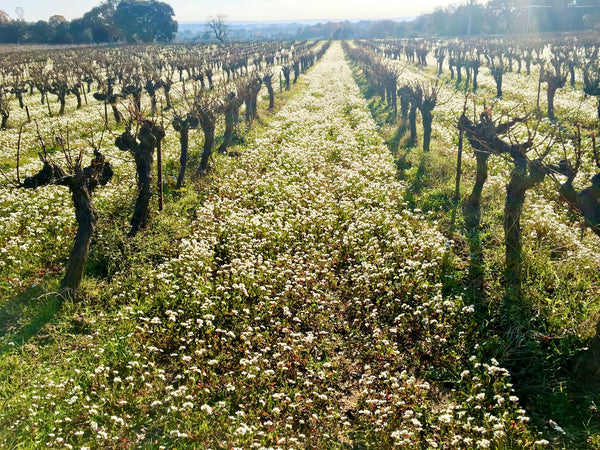
One of my favorite moments in Provence has rolled in: les vendanges (harvest period). The full harvest is here, the hills thick with pickers. One of my daughter’s friends at school comes from a long line of viticulteurs (wine growers). I chat with her mother and when we talk weather, it is not a casual subject. I see worry crease her forehead as temperatures spike, or in a month of no rain, or during a deep freeze in winter. She is tied to her vines in a raw, visceral way.
Even if September is the famous month of gathering, the work is year-round for wine-growers. Each month, the vines are transformed.

In the winter months, the vines are bare wood sculptures, standing in formation in the fields. These months bring careful pruning, an act of anticipating the journey of the sap through the vine. When pruning, the wine growers train the trunk of the vine to deal well with the growth of the shoots. By pruning the vine, they limit the production of fruit to make sure the grapes that come to bear are the best and sweetest. On my winter runs through the vineyards, I like to watch the pruners moving haltingly, their work seemingly as slow and frozen as the landscape around.

Early spring brings fears of frost, which can be devastating. Weeding in between the rows starts - in an endless succession. The magic truly begins as the first buds appear in late March and early April: green lucent sprouts, almost neon in color. The wine growers disbud the vines, keeping only select buds in order to make sure the foliage and eventual fruit won’t overpower the plant. For the wine grower, training the vine is a constant process.

In late May, if you walk among the vines around our house at sunset, the sweetest aroma fills the air. It is the perfume of new flowers burgeoning on the vines. It is intoxicating.
 |
 |
| May evening among the vines in Provence | |
In June, many wine growers in Provence walk the rows of their vines weighed down by large contraptions on their backs. They are pulverizing the soil around the vines. This enriches the soil. Then later in the month, they vaporize the foliage with a silicate fertilizer.
I saw my neighbor, who is 85-years old, out in his fields performing this ritual. He has continued his family’s long-held tradition of wine cultivation all his life. I asked him about what he was doing out there. He called the process spraying the leaves with a “magical crystal that traps the light.” Growers like him avoid pesticides at all costs and are proud to bear the organic stamp on their bottles of wine.
With sincere eyes, he talked about the philosophy of Rudolph Steiner. The planting and care of his vines must follow the skies, the constellations. His vines are alive, of course, but the earth itself is a living organism for him. To me, the most touching aspect of witnessing wine production in Provence is the grower’s connection to their plot of earth.

I’ve always admired the roses planted in vineyards at the ends of the rows. I didn’t know it, but they serve an important purpose. My neighbor explained that he plants his roses as harbingers of disease; the roses show the effects of insects and rot first. Early treatment brings the best results.

By July, the flowers have become berries and the work of stripping the rows of soil between the vines begins. In August, the wine grower aerates the vine, taking the time to drop the bunches of grapes by hand so that they hang down freely. This is a precaution to avoid noble rot, the bête noire of any wine grower. The grapes are beginning to truly ripen this month.

Then, the apotheosis: the harvest. I’ve asked wine growers here in Provence how they know exactly when their grapes are ready. When harvest time approaches, they are out tasting the nectar of their fruit multiple times a day. It is an all-senses rite. They scrutinize, they smell, they feel, they crush, they taste. When the skin of the grape is no longer taut, when the pulp doesn’t crunch and when the seed itself is very brown, the harvest should begin without delay. The key for them is to achieve a balance point between the sugar and the acidity of the grape, in consideration of the style of wine they are growing.
At all the best domaines, harvest picking is done by hand. Every bunch of grapes is selected. This is tedious work, done by lines of pickers, bent over in the vines. They pass baskets and buckets of cut grapes down the long line to the tractor. The picking may be 3 to 4 days. Then, the grapes are transferred to the wine press. The juice is young and spirited and begins fermenting quickly, eventually transferred into wood barrels for aging.

I am here admiring an early batch of our work at a friend’s domain in between picking during last year’s harvest
After the harvest, October stains the vines gold and crimson. Soon their leaves will fall.

Around this time, we like to go on picnics in the vineyards behind our house. We glean (in French: “grappiller”) for dessert - les vendanges leave some lingering fruit untouched. Ripe and sweet as can be. With time, the remaining grapes turn to raisins, still hanging there. They are a delectable treat through Christmas, especially when warmed by the sun on a December day (a secret shared by locals here).

And on it goes, every year a grand cycle to witness.

Snow in Provence (to the sound of bees), just in time for Christmas



